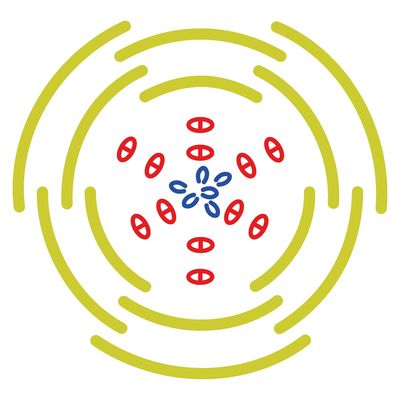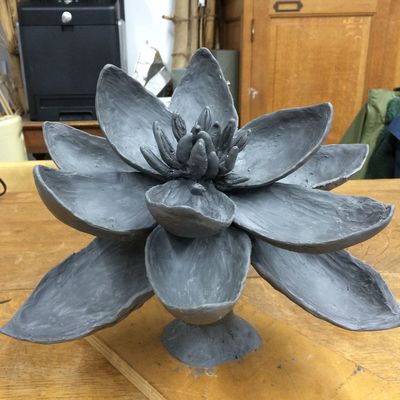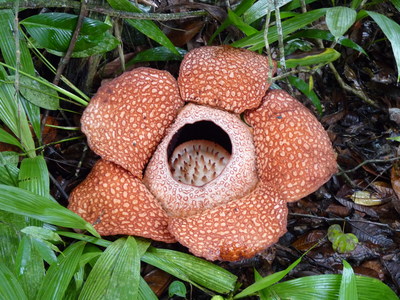Three weeks after the release of our paper on the reconstructed ancestral flower in Nature Communications, I would like to share a few personal impressions on the media coverage of our story.
Although we planned for this (with several press releases in multiple languages) and hoped for some attention by the media, we have been overwhelmed by the public response to our paper. The story has been featured in more than 100 independent articles written in at least 23 different languages. We are of course thrilled about this. Who wouldn't be after working hard in the shadow on a large project like this for more than six years?
I have been recently convinced of the critical importance for us scientists to play an active role in public outreach, in whichever form it takes (see this post I wrote on the topic a few months ago). Here I need to clarify that I do not think that all scientific work can easily be promoted in the media, nor do I think that work that receives media attention is more important than other studies. But I am now convinced that looking for media attention, when the topic is suitable, can be very beneficial for both science and society.
Our eFLOWER project and paper are about much more than the ancestral flower, but we deliberately chose this angle early on because we had the intuition that it would appeal to general public interest (and, admittedly, help us target top journals). Over the years, I was comforted in this feeling when I talked about this study to many family members, friends, and colleagues from other disciplines. I was particularly affected (positively) when I explained the project to my young nieces and nephews on top of the French Alps three summers ago and realized that they could understand and even be excited about this work.
These are the reasons why we deliberately decided to portray a realistic 3D model of the ancestral flower, compatible with the results from our study. It was our key to public outreach, and it worked very well for this purpose!
We even made a short video of it (provided as Supplementary Movie 1 in our paper):
Although we planned for this (with several press releases in multiple languages) and hoped for some attention by the media, we have been overwhelmed by the public response to our paper. The story has been featured in more than 100 independent articles written in at least 23 different languages. We are of course thrilled about this. Who wouldn't be after working hard in the shadow on a large project like this for more than six years?
I have been recently convinced of the critical importance for us scientists to play an active role in public outreach, in whichever form it takes (see this post I wrote on the topic a few months ago). Here I need to clarify that I do not think that all scientific work can easily be promoted in the media, nor do I think that work that receives media attention is more important than other studies. But I am now convinced that looking for media attention, when the topic is suitable, can be very beneficial for both science and society.
Our eFLOWER project and paper are about much more than the ancestral flower, but we deliberately chose this angle early on because we had the intuition that it would appeal to general public interest (and, admittedly, help us target top journals). Over the years, I was comforted in this feeling when I talked about this study to many family members, friends, and colleagues from other disciplines. I was particularly affected (positively) when I explained the project to my young nieces and nephews on top of the French Alps three summers ago and realized that they could understand and even be excited about this work.
These are the reasons why we deliberately decided to portray a realistic 3D model of the ancestral flower, compatible with the results from our study. It was our key to public outreach, and it worked very well for this purpose!
We even made a short video of it (provided as Supplementary Movie 1 in our paper):
However, our choice to offer a single portrait of the hypothesized ancestral flower was risky because:
This leads me to the unfortunate comparison with magnolia flowers (or other species such as water lilies or lotus) made in various media articles and abundant in comments by the general public.
First, it is essential to understand that these potential resemblances are only superficial. Most magnolia flowers, for instance, only have three trimerous whorls of tepals, many more stamens and carpels than pictured in our 3D model, the stamens are spirally arranged (not whorled), and stamens and carpels are borne on an elongated receptacle (unlike our model, although this choice was arbitrary because we did not reconstruct this character). Water lilies usually have more perianth whorls and these are tetramerous (or higher merism), not trimerous, and the carpels are whorled and fused, much unlike our 3D model.
Yet, you might think that these are subtle differences mostly of interest to botanists, not the general public, so why are we avoiding so much these comparisons? Well, there are many good reasons:
- we did not reconstruct relative sizes of organs, nor their shape or color (these traits are much too variable among living flowers to trace back 140 million years ago)
- 100 million other versions of this portrait would have been possible, given our results, which concerned only main structural traits such as number of parts, phyllotaxis, or symmetry
- much uncertainty remains in some of the traits we reconstructed (as clearly indicated on the original Fig. 1 of the paper and reported in the text and supplementary discussion)
This leads me to the unfortunate comparison with magnolia flowers (or other species such as water lilies or lotus) made in various media articles and abundant in comments by the general public.
First, it is essential to understand that these potential resemblances are only superficial. Most magnolia flowers, for instance, only have three trimerous whorls of tepals, many more stamens and carpels than pictured in our 3D model, the stamens are spirally arranged (not whorled), and stamens and carpels are borne on an elongated receptacle (unlike our model, although this choice was arbitrary because we did not reconstruct this character). Water lilies usually have more perianth whorls and these are tetramerous (or higher merism), not trimerous, and the carpels are whorled and fused, much unlike our 3D model.
Yet, you might think that these are subtle differences mostly of interest to botanists, not the general public, so why are we avoiding so much these comparisons? Well, there are many good reasons:
- Direct comparisons of a 140-million year old ancestor with any living species is reminiscent of an old obsession by evolutionary biologists themselves, mostly throughout the 20th century, to try and find "most primitive" species among living members of a group. However, we no longer think of evolution this way, and instead view all living species (including you, me, the magnolia, and all other plants, animals, fungi, and microbes!) as the tips of the deep phylogenetic tree that connects us all. We have all evolved, in one way or another, since our deep-time ancestors, and that is true of all flowering plants (see this video I made on Plant evolution).
- As outlined above, any superficial resemblance with any living species to the nonbotanist eye is based mostly on arbitrary traits (size, shape, color, the general presentation of the open flower) that we have not analyzed in our paper. Therefore, this resemblance is mostly the result of the artist's touch, which we did not attempt to influence one way or another. I will explain in a future post or video how the 3D model was actually designed (see our Supplementary Information), but basically we provided the floral diagram below (based on our final results) to the illustrator and our main concern was that the 3D sculpture (below, center) that she made and that we subsequently scanned would be scientifically accurate for the floral structural traits that we analyzed.
From ancestral floral diagram to sculpture to 3D model: only the diagram is restricted to the results from our analyses, whereas the sculpture and colored 3D model inevitably include some arbitrariness for size, shape, and color (not reconstructed in our paper). However, the 3D model talks to a much broader audience than the diagram.
- Magnolias (and related magnoliid families) have long thought and been taught to be highly "primitive" flowering plants. This is no longer true, we no longer think of evolution this way. In fact, magnolias, just like water lilies and lotus flowers, are probably freak flowers that evolved through secondary gigantism (and multiplication of stamens and carpels), a bit like parasitic rafflesias (the largest flowers in the world) evolved from much smaller flowers. OK, I admit, the comparison is a bit far-stretched, but you get the picture. In fact, most fossil flowers known from the Cretaceous are tiny, less than 1 cm wide! This is why we are particularly allergic to the magnolia comparison.
Rafflesia and magnolia: think of both as freak flowers (secondary giants that probably look very different from their ancestors).
"Which modern-day flower does it resemble most?" was in fact one of the most common questions asked by journalists. I hope I have clarified why we refrained so much to offer any candidate, and why I often answered 'none, or all' to that question to avoid perpetrating obsolete concepts about evolution. Interestingly, the issue was also raised by a reviewer. You may find his/her comments as well as our response in the open peer review file attached to our paper.
So what is my main message here? We took the risk of offering a realistic, yet partly arbitrary image for our reconstructed ancestral flower, not everyone is happy with this specific image (some co-authors for instance were uncomfortable with the artist's choices), and it has prompted unavoidable direct comparisons with living flowers despite our best efforts to avoid them.
Although only time will tell, I actually think it does not matter! What is more important is that the mainstream media and general public have talked and learned something about floral evolution.
The main take-home messages from the media and the general public are actually very different from those of our article:
If these are to be the main, unexpected impact points of our public outreach campaign, I will be glad and it was worth it! And if anyone is unhappy with the specifics of our particular 3D model to portray our results, I encourage them to produce new ones and I'll be very happy to review technical consistency with our study!
Examples of media coverage of the eFLOWER story:
So what is my main message here? We took the risk of offering a realistic, yet partly arbitrary image for our reconstructed ancestral flower, not everyone is happy with this specific image (some co-authors for instance were uncomfortable with the artist's choices), and it has prompted unavoidable direct comparisons with living flowers despite our best efforts to avoid them.
Although only time will tell, I actually think it does not matter! What is more important is that the mainstream media and general public have talked and learned something about floral evolution.
The main take-home messages from the media and the general public are actually very different from those of our article:
- all living flowers ultimately derive from a single ancestor, which also had a flower and lived at least 140 million years ago (in other words, flowering plants are monophyletic)
- the ancestral flower was bisexual and so are most living flowers; which led to this hilarious article by Pink News
- it is actually possible to go back in past and make inferences on ancestral features using a method called ancestral state reconstruction
If these are to be the main, unexpected impact points of our public outreach campaign, I will be glad and it was worth it! And if anyone is unhappy with the specifics of our particular 3D model to portray our results, I encourage them to produce new ones and I'll be very happy to review technical consistency with our study!
Examples of media coverage of the eFLOWER story:
- BBC: Did the first flower look like this?
- Discover: First Look At The First Flower, Ancestral To All Others
- Live Science: Blossoming Bisexual: World's 1st Flower Had Male and Female Parts
- New Scientist: What the first flower on Earth might have looked like
- Science: The world’s first flower may have looked like this
- The Guardian: Mother of all blooms: is this what the last common ancestor of flowers looked like?
- The Times: Scientists reconstruct the first flower
- USA Today: Prehistoric petals: Scientists reveal what the first flower looked like






 RSS Feed
RSS Feed
